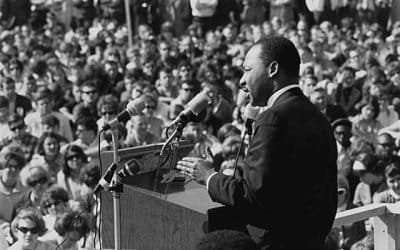Giving kids a better grasp of what America means usually begins with a good book. The combination of appealing pictures and exciting ideas may spark a young person’s interest to learn more about a topic. Several classic children’s books offer reasons to celebrate America’s birthday.
Sometime between serving hot dogs on paper plates and watching fireworks, patriotic parents and grandparents might use these literary tools to help put Thursday’s Fourth of July in its proper perspective — as Independence Day — for future generations.
Archibald McNeal Willard’s stirring, famous painting, “Spirit of 1776” adorns the cover of Edward Eggleston’s “A History of the United States and Its People,” first published in 1888 (reproduced by Lost Classics Book Company; $24.95). Willard’s Revolutionary War painting, depicting a trio of battle weary but undaunted musicians, unforgettably captures the rising nation’s fierce determination and is the perfect cover for this exhaustive and accessible volume. “History” is both America’s early story and a fun, challenging workbook.
Eggleston (1837-1902), a former president of the American History Association, filled “History” with fascinating sidebars, drawings and exercises. He included over 400 maps and illustrations, pronunciations and suggestions for creative projects.
The author staunchly opposed slavery, refusing to attend the University of Virginia on principle. In his book he notes slavery is one of the Constitution’s contradictions. But he is also objective: America’s mistakes do not dominate the text, and he writes with an unmistakable reverence for the United States.
“History” is most suitable for older and especially bright younger kids and it’s a handy reference in any case. Also by Eggleston: “A First Book in American History” (Lost Classics; $24.95) and “Stories of Great Americans for Little Americans” (Lost Classics; $17.95), which profiles Longfellow, Lewis and Clark, Jefferson, Kit Carson, Daniel Boone and many others. Both are recommended for ages 6 through 8.
For ages 6 and up, “Stagecoach: The Ride of a Century,” by A. Richard Mansir, (Charlesbridge; $6.95) is a lively and well-written volume that manages to evoke the American West and practically put the child in the stagecoach.
The history is solid — Mansir correctly reports it wasn’t the railroad that put the stage out of business; it was the automobile — and the subject matter is fun. Stagecoach rules include: “In the event of runaway horses, remain calm.”
You should also check out “Build a Wells Fargo Stagecoach” by the same author (Charlesbridge; $6.95), which features easy to assemble, press-out parts for an authentic model. Also available from the publisher’s Building America Series: “Build a Covered Wagon” and “Build a Mississippi Riverboat.”
The first in a series of great pioneer stories is Laura Ingalls Wilder’s “Little House in the Big Woods” (HarperCollins Children’s Books; $6.99). The famous franchise began in 1932, when Wilder, at age 65, started writing about life in the Ingalls family’s Pepin, Wis., log house. By the time the eight-volume series was finished in 1943, Wilder had written about American life in Wisconsin, Kansas, Minnesota and South Dakota. She died in 1957 at age 90.
“The Story of the Statue of Liberty” (Mulberry Books; $6.95), as told by Betsy Maestro with Giulio Maestro’s striking illustrations, begins 15 years before Lady Liberty first welcomed immigrants in New York Harbor. That’s when French sculptor Frederic Bartholdi visited New York City to conceptualize the work of art he would later give to the American people as a gift from France.
Originally published in 1989, this book of rich watercolor panoramas and a simple story is intended for ages 3 and up. The sense of wonder is fully captured by the drawings, including one portraying cranes and cables supporting workers as they place the enormous cloak on Liberty’s steel frame. An indispensable feature for children: Emma Lazarus’ beautiful words, the perfect poetic match to what may be America’s most beloved monument.
Taking the little ones from the Earth to the moon is easy with the cleverly conceived “Footprints on the Moon” (Charlesbridge; $7.95) by Alexandra Siy. While many adults probably recall the moment Neil Armstrong first stepped on the moon, kids are unlikely to appreciate the glory of America’s space exploration.
“Footprints” provides a wondrous introduction to Apollo’s early days, as well as background on Galileo, the Wright brothers and rockets. Siy wisely includes a chronology of moon exploration, Web sites and other books for deeper probing.
“Steam, Smoke, and Steel: Back in Time With Trains” by Patrick O’Brien, (Charlesbridge; $6.95) covers not only trains but the history of railroads in a creative, fictional narrative. Train lovers and others will find the well-designed book’s paintings on horizontal, double-page spreads inviting.
O’Brien traces every element of the railroad: the daring brakemen, who braved icy roofs car by car to stop the train; the engineers; and a clear but thorough explanation of each locomotive and how it worked.
Go from trains to planes using the alphabet with “The Airplane Alphabet Book” (Charlesbridge; $6.95), both a tribute to the airplane and a story of flight for kids. “Airplane,” which covers everything from the Wright brothers’ plane to Charles Lindbergh’s Spirit of St. Louis to more recent aircraft, is written with wit by veteran children’s alphabet book authors Jerry Pallotta and Fred Stillwell with illustrations by Rob Bolster. Also available and just as much fun: Pallotta’s “The Jet Alphabet Book” and “The Boat Alphabet Book.”
Kids will find greater appreciation for Francis Scott Key’s “The Star-Spangled Banner” after reading Patricia Ryon Quiri’s “The National Anthem” (Children’s Press; $6.95). Chapters chronicle the fierce battle in Baltimore between the English navy and the U.S. Army for Fort McHenry — where Key was inspired to write the anthem. Full-color reproductions of famous paintings accompany the dramatic story, which includes a list for further reading, related Web sites and organizations, and a glossary.
Pam Munoz Ryan’s popular book “The Flag We Love” (Charlesbridge; $7.95) examines the flag’s origins and its use by athletes, explorers and veterans. “Flag” combines Ralph Masiello’s illustrations with historic prose and poetry, including this timely stanza: “A citizen wears a symbol/A tiny, flag shaped pin/As a promise of our future/And a reminder of where we’ve been.”




